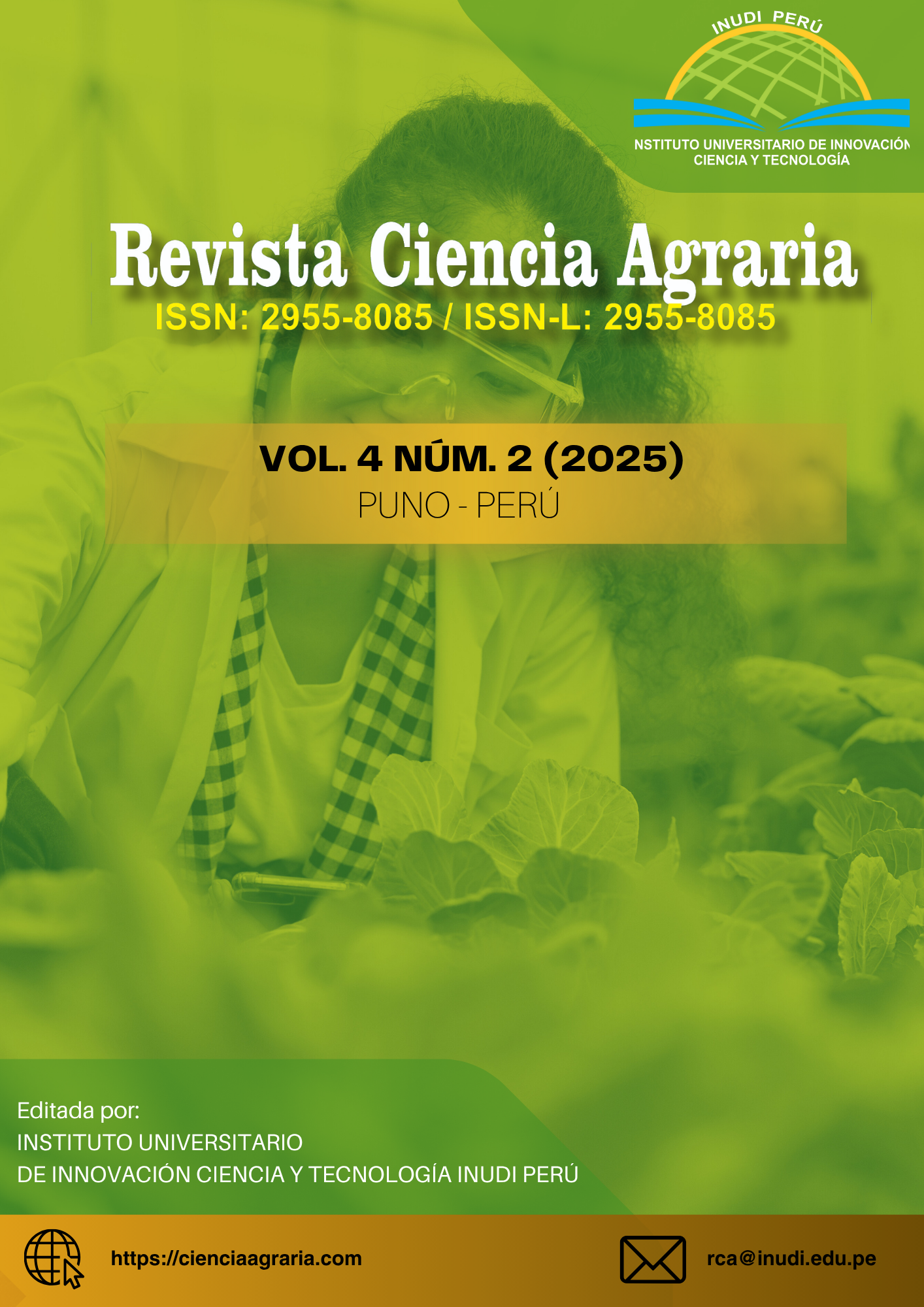Validation process of the calcination method for determining the organic matter content in soil samples from Peru
DOI:
https://doi.org/10.35622/Keywords:
correlation, organic matter, wet oxidation, loss on ignitionAbstract
Soil organic matter (SOM) is a key indicator of soil quality due to its impact on physical, chemical, and biological properties. The standardized method in Peru for determining SOM is wet oxidation, which requires the use of controlled chemical reagents; however, their improper disposal poses a risk of environmental contamination. As an alternative, the calcination method can be used, which is less polluting, although the operating temperatures have not yet been standardized nationwide. The aim of this research is to compare the calcination method at three different ignition temperatures with the standardized method. A total of 61 soil samples from various regions of Peru, exhibiting different SOM and CaCO₃ contents, were analyzed. Calcination temperatures were set at 400 °C, 500 °C, and 600 °C. The results compared SOM determined by wet oxidation and SOM determined by calcination using the Wilcoxon test, which showed significant differences (p < 0.05). Linear regression equations were developed to evaluate the correlation between both procedures, and SOM obtained by calcination at the three temperatures showed a strong linear correlation (adjusted R² = 0.88). Among the regression equations for each calcination temperature, the 400 °C treatment exhibited the highest correlation with the standardized method (adjusted R² = 0.92, p < 0.005). These findings suggest that the calcination method at 400 °C can be a useful approach to estimate soil organic matter content across different soil types.
References
Bazán, R. (2017). Manual de procedimientos de los análisis de suelos y agua con fines de riego. Ministerio de Agricultura y Riego/Instituto Nacional de Innovación Agraria.
Ćirić, V., Prekop, N., Šeremešić, S., Vojnov, B., Pejić, B., Radovanović, D., & Marinković, D. (2023). The implication of Cation Exchange Capacity (cec) assessment for soil quality management and improvement. Agriculture & Forestry/Poljoprivreda i šumarstv, 69(4). DOI:10.17707/AgricultForest.69.4.08
Combs, S. M., & Nathan, M. V. (1998). Soil organic matter. In J. R. Brown (Ed.), Recommended chemical soil test procedures for the North Central Region (North Central Regional Research Publication No. 221, Revised ed., pp. 53–58). Missouri Agricultural Experiment Station SB 1001. https://www.canr.msu.edu/uploads/234/68557/rec_chem_soil_test_proce55c.pdf
Eyherabide, M., Saínz Rozas, H., Barbieri, P., & Echeverría, H. E. (2014). Comparación de métodos para determinar carbono orgánico en suelo. Ciencia del suelo, 32(1), 13-19. https://ri.conicet.gov.ar/bitstream/handle/11336/25777/CONICET_Digital_Nro.6092f0df-9d4b-4597-a8ad-7433176558ac_A.pdf?sequence=2&isAllowed=y
Food and Agriculture Organization. (2017). Mapa del carbono orgánico del suelo. Organización de las Naciones Unidas para la Alimentación y la Agricultura/FAO. https://openknowledge.fao.org/server/api/core/bitstreams/0321e0f3-9e17-4f9f-9430-253d0f67f736/content
Kristl, M., Mursec, M., Sustar, V., & Kristl, J. (2015). Application of thermogravimetric analysis for the evaluation of organic and inorganic carbon contents in agricultural soils. Journal of Thermal Analysis and Calorimetry, 123(3), 2139-2147. https://link.springer.com/article/10.1007/s10973-015-4844-1
Martínez, H., Fuentes, E., y Acevedo, H. (2008). Carbono orgánico del suelo y propiedades del suelo. Revista de la ciencia del suelo y nutrición vegetal, 8(1). http://dx.doi.org/10.4067/S0718-27912008000100006
Martínez, J. M., Galantini, J. A., Duval, M. E., López, F. M., and Iglesias, J. O. (2018). Estimating soil organic carbon in Mollisols and its particle-size fractions by loss-on-ignition in the semiarid and semihumid Argentinean Pampas. Geoderma Regional, 12, 49-55. https://doi.org/10.1016/j.geodrs.2017.12.004
Sadzawka, A., Carrasco, M., Grez, R., De La Luz Mora, M., Flores, H. y Neaman, A. (2006). Métodos de análisis recomendados para los suelos de Chile (Revisión 2006). Serie Actas INIA (Instituto de Investigación Agropecuaria) N°34. Ministerio de Agricultura/Gobierno de Chile. https://www.schcs.cl/wp-content/uploads/2018/11/Analisis-de-suelos.pdf
Schulte, E. E., & Hopkins, B. G. (1996). Estimation of soil organic matter by weight loss-on-ignition. In F. R. Magdoff, M. A. Tabatabai, & E. A. Hanlon Jr. (Eds.), Soil organic matter: Analysis and interpretation (Vol. 46, Chap. 3). SSSA Special Publications. https://doi.org/10.2136/sssaspecpub46.c3
Shamrikova, E. V., Vanchikova, E. V., Lu-Lyan-Min, E. I., Kubik, O. S., & Zhangurov, E. V. (2023). Which method to choose for measurement of oranic and inorganic carbon content in carbonate-rich soils? Advantages and disadvantages of dry and wet chemistry. Catena, 228, 107151. https://www.sciencedirect.com/science/article/pii/S0341816223002424?via%3Dihub
Van Bemmelen, J. M. (1890). Über die Bestimmung des Wassers, des Humus, des Schwefels, der in den colloïdalen Silikaten gebundenen Kieselsäure, des Mangans u. s. w. im Ackerboden. Die Landwirthschaftlichen Versuchs-Stationen, 37, 279–290. https://edepot.wur.nl/211282
Wang, X., Wang, J., & Zhang, J. (2012). Comparisons of three methods for organic and inorganic carbon in calcareous soils of Northwestern China. PLOS ONE, 7(8), e44334. https://doi.org/10.1371/journal.pone.0044334
Walkley, A., & Black, I. A. (1934). An examination of the Degtjareff method for determining organic carbon in soils: Effect of variations in digestion conditions and of inorganic soil constituents. Soil Science, 63, 251–263. https://www.scirp.org/reference/ReferencesPapers?ReferenceID=2196695
Downloads
Published
Issue
Section
License
Copyright (c) 2025 Sumiry Aguilar, Carlos Mestanza, Braulio La Torre, Berthin Ticona (Autor/a)

This work is licensed under a Creative Commons Attribution 4.0 International License.











